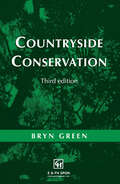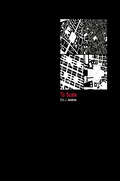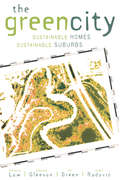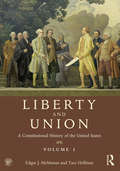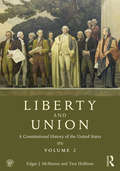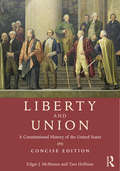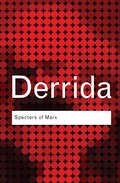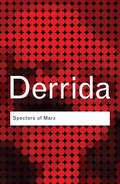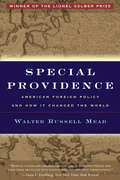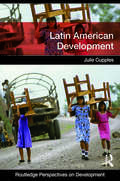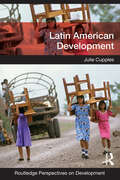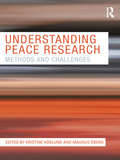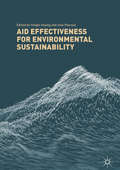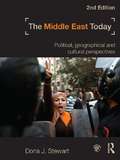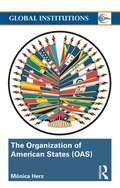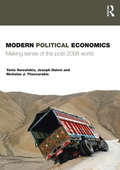- Table View
- List View
Countryside Conservation: Land Ecology, Planning and Management
by Bryn GreenThis third edition of the standard text Countryside Conservation charts and evaluates those changes which represent a fundamental revolution in the ways in which the countryside is planned and managed. It sets out the principles, policies and practice which underlie the ecology, planning and management of the new countryside, discussing ways in which countryside conservation objectives are evolving and how they can best be achieved.
To Scale: One Hundred Urban Plans
by Eric JenkinsHow big is Moscow’s Red Square in comparison to Tiananmen Square? Why are there fewer public squares in Japan than in Italy? What lessons might be found in the plan of Savannah, Georgia’s historic district? To Scale is a collection of plans of urban spaces drawn at the same scale to help answer these questions by providing a single and accurate resource of urban plans for architects, urban designers, planners and teachers, and students. The book contains one hundred figure-ground plans from seventy-eight cities around the world, describing an identical area (half a kilometer square) for each urban space. Accompanying each plan are photographs, diagrams and text that illustrate essential aspects of the plan or urban space for the designer. This compilation is an excellent resource helping to visualize, compare and reconceptualize urban design for students wanting to understand the lessons of existing cities and the making of urban spaces.
To Scale: One Hundred Urban Plans
by Eric JenkinsHow big is Moscow’s Red Square in comparison to Tiananmen Square? Why are there fewer public squares in Japan than in Italy? What lessons might be found in the plan of Savannah, Georgia’s historic district? To Scale is a collection of plans of urban spaces drawn at the same scale to help answer these questions by providing a single and accurate resource of urban plans for architects, urban designers, planners and teachers, and students. The book contains one hundred figure-ground plans from seventy-eight cities around the world, describing an identical area (half a kilometer square) for each urban space. Accompanying each plan are photographs, diagrams and text that illustrate essential aspects of the plan or urban space for the designer. This compilation is an excellent resource helping to visualize, compare and reconceptualize urban design for students wanting to understand the lessons of existing cities and the making of urban spaces.
The Green City: Sustainable Homes, Sustainable Suburbs
by Nicholas Low Brendon Gleeson Ray Green Darko RadovicA team of city-building professionals explain in straightforward terms how the idea of ecological sustainability can be embodied in the everyday life of homes, communities and cities to make a better future.The book considers - and answers - three questions: What does the global agenda of sustainable development mean for the urban spaces where most people live, work and move? Can we keep what we love about suburban life and still save the environment? And what new methods of planning and building will be needed in the 21st century? Rejecting both economic and environmental orthodoxy, the book’s essential message is that the sustainable city can be built by a thousand well-directed small changes. It draws on practical case material from around the world and weaves together four critical aspects of urban life: housing, open space, workplaces and transport. A 'photographic essay' of 32 colour plates illustrates the ideas discussed.
Liberty and Union: A Constitutional History of the United States, volume 1
by Edgar J. McManus Tara HelfmanThis, the first of two volumes of Liberty and Union, is a comprehensive constitutional history of the United States from the Anglo-American origins of the Constitution through the colonial and antebellum periods, to the Civil War and the consequent restructuring of the nation. Written in a clear and engaging narrative style, it successfully unites thorough chronological coverage with a thematic approach, offering critical analysis of core constitutional history topics, set in the political, social, and economic context that made them constitutional issues in the first place. Combining a thoughtful and balanced narrative with an authoritative stance on key issues, the authors explain the past in the light of the past, without imposing upon it the standards of later generations. Authored by two experienced professors of History and Law this textbook has been thoughtfully constructed to offer an accessible alternative to dense scholarly works – avoiding unnecessary technical jargon, defining legal terms and historical personalities where appropriate, and making explicit connections between constitutional themes and historical events. For students in an undergraduate or postgraduate constitutional history course, or anyone with a general interest in constitutional developments, this book will be essential reading. Useful features include: Full glossary of legal terminology Recommended reading A table of cases Extensive supporting artwork Companion website Useful documents provided: Declaration of Independence Articles of Confederation Constitution of the United States of America Chronological list of Supreme Court justices
Liberty and Union: A Constitutional History of the United States, volume 1
by Edgar J. McManus Tara HelfmanThis, the first of two volumes of Liberty and Union, is a comprehensive constitutional history of the United States from the Anglo-American origins of the Constitution through the colonial and antebellum periods, to the Civil War and the consequent restructuring of the nation. Written in a clear and engaging narrative style, it successfully unites thorough chronological coverage with a thematic approach, offering critical analysis of core constitutional history topics, set in the political, social, and economic context that made them constitutional issues in the first place. Combining a thoughtful and balanced narrative with an authoritative stance on key issues, the authors explain the past in the light of the past, without imposing upon it the standards of later generations. Authored by two experienced professors of History and Law this textbook has been thoughtfully constructed to offer an accessible alternative to dense scholarly works – avoiding unnecessary technical jargon, defining legal terms and historical personalities where appropriate, and making explicit connections between constitutional themes and historical events. For students in an undergraduate or postgraduate constitutional history course, or anyone with a general interest in constitutional developments, this book will be essential reading. Useful features include: Full glossary of legal terminology Recommended reading A table of cases Extensive supporting artwork Companion website Useful documents provided: Declaration of Independence Articles of Confederation Constitution of the United States of America Chronological list of Supreme Court justices
Liberty and Union: A Constitutional History of the United States, volume 2
by Edgar J. McManus Tara HelfmanThis, the second of two volumes of Liberty and Union, is a comprehensive constitutional history of the United States from the Progressive Era of the early twentieth century to the most recent decisions of the Supreme Court on contemporary constitutional issues. Written in a clear and engaging narrative style, it successfully unites thorough chronological coverage with a thematic approach, offering critical analysis of core constitutional history topics, set in the political, social, and economic context that made them constitutional issues in the first place. Combining a thoughtful and balanced narrative with an authoritative stance on key issues, the authors deliberately explain the past in the light of the past, without imposing upon it the standards of later generations. Authored by two experienced professors in the field, this textbook has been thoughtfully constructed to offer an accessible alternative to dense scholarly works – avoiding unnecessary technical jargon, defining legal terms and historical personalities where appropriate, and making explicit connections between constitutional themes and historical events. For students in an undergraduate or postgraduate constitutional history course, or anyone with a general interest in constitutional developments, this book will be essential reading. Useful features include: Full glossary of legal terminology Recommended reading A table of cases Extracts from primary documents Companion website Useful documents provided: Declaration of Independence Articles of Confederation Constitution of the United States of America Chronological list of Supreme Court justices
Liberty and Union: A Constitutional History of the United States, volume 2
by Edgar J. McManus Tara HelfmanThis, the second of two volumes of Liberty and Union, is a comprehensive constitutional history of the United States from the Progressive Era of the early twentieth century to the most recent decisions of the Supreme Court on contemporary constitutional issues. Written in a clear and engaging narrative style, it successfully unites thorough chronological coverage with a thematic approach, offering critical analysis of core constitutional history topics, set in the political, social, and economic context that made them constitutional issues in the first place. Combining a thoughtful and balanced narrative with an authoritative stance on key issues, the authors deliberately explain the past in the light of the past, without imposing upon it the standards of later generations. Authored by two experienced professors in the field, this textbook has been thoughtfully constructed to offer an accessible alternative to dense scholarly works – avoiding unnecessary technical jargon, defining legal terms and historical personalities where appropriate, and making explicit connections between constitutional themes and historical events. For students in an undergraduate or postgraduate constitutional history course, or anyone with a general interest in constitutional developments, this book will be essential reading. Useful features include: Full glossary of legal terminology Recommended reading A table of cases Extracts from primary documents Companion website Useful documents provided: Declaration of Independence Articles of Confederation Constitution of the United States of America Chronological list of Supreme Court justices
Liberty and Union: A Constitutional History of the United States, concise edition
by Edgar J. McManus Tara HelfmanThis, the concise edition of Liberty and Union, is an abridged constitutional history of the United States, designed for short single-semester courses, comprising the key topics from Volumes 1 and 2. Written in a clear and engaging narrative style, it successfully unites thorough chronological coverage with a thematic approach, offering critical analysis of core constitutional history topics, set in the political, social, and economic context that made them constitutional issues in the first place. Combining a thoughtful and balanced narrative with an authoritative stance on key issues, the authors deliberately explain the past in the light of the past, without imposing upon it the standards of later generations. Authored by two experienced professors in the field, this concise edition presents seminal topics while retaining the narrative flow of the two full original volumes. An accessible alternative to dense scholarly works, this textbook avoids unnecessary technical jargon, defines legal terms and historical personalities where appropriate, and makes explicit connections between constitutional themes and historical events. For students in a short undergraduate or postgraduate constitutional history course, or anyone with a general interest in constitutional developments, this book will be essential reading. Useful features include: Full glossary of legal terminology Recommended reading A table of cases Extracts from primary documents Companion website Useful documents provided: Declaration of Independence Articles of Confederation Constitution of the United States of America Chronological list of Supreme Court justices
Liberty and Union: A Constitutional History of the United States, concise edition
by Edgar J. McManus Tara HelfmanThis, the concise edition of Liberty and Union, is an abridged constitutional history of the United States, designed for short single-semester courses, comprising the key topics from Volumes 1 and 2. Written in a clear and engaging narrative style, it successfully unites thorough chronological coverage with a thematic approach, offering critical analysis of core constitutional history topics, set in the political, social, and economic context that made them constitutional issues in the first place. Combining a thoughtful and balanced narrative with an authoritative stance on key issues, the authors deliberately explain the past in the light of the past, without imposing upon it the standards of later generations. Authored by two experienced professors in the field, this concise edition presents seminal topics while retaining the narrative flow of the two full original volumes. An accessible alternative to dense scholarly works, this textbook avoids unnecessary technical jargon, defines legal terms and historical personalities where appropriate, and makes explicit connections between constitutional themes and historical events. For students in a short undergraduate or postgraduate constitutional history course, or anyone with a general interest in constitutional developments, this book will be essential reading. Useful features include: Full glossary of legal terminology Recommended reading A table of cases Extracts from primary documents Companion website Useful documents provided: Declaration of Independence Articles of Confederation Constitution of the United States of America Chronological list of Supreme Court justices
Specters of Marx: The State of the Debt, the Work of Mourning and the New International
by Jacques DerridaProdigiously influential, Jacques Derrida gave rise to a comprehensive rethinking of the basic concepts and categories of Western philosophy in the latter part of the twentieth century, with writings central to our understanding of language, meaning, identity, ethics and values. In 1993, a conference was organized around the question, 'Whither Marxism?’, and Derrida was invited to open the proceedings. His plenary address, 'Specters of Marx', delivered in two parts, forms the basis of this book. Hotly debated when it was first published, a rapidly changing world and world politics have scarcely dented the relevance of this book.
Specters of Marx: The State of the Debt, the Work of Mourning and the New International
by Jacques DerridaProdigiously influential, Jacques Derrida gave rise to a comprehensive rethinking of the basic concepts and categories of Western philosophy in the latter part of the twentieth century, with writings central to our understanding of language, meaning, identity, ethics and values. In 1993, a conference was organized around the question, 'Whither Marxism?’, and Derrida was invited to open the proceedings. His plenary address, 'Specters of Marx', delivered in two parts, forms the basis of this book. Hotly debated when it was first published, a rapidly changing world and world politics have scarcely dented the relevance of this book.
Special Providence: American Foreign Policy and How It Changed the World
by Walter Russell Mead"God has a special providence for fools, drunks and the United States of America."--Otto von BismarckAmerica's response to the September 11 attacks spotlighted many of the country's longstanding goals on the world stage: to protect liberty at home, to secure America's economic interests, to spread democracy in totalitarian regimes and to vanquish the enemy utterly.One of America's leading foreign policy thinkers, Walter Russell Mead, argues that these diverse, conflicting impulses have in fact been the key to the U.S.'s success in the world. In a sweeping new synthesis, Mead uncovers four distinct historical patterns in foreign policy, each exemplified by a towering figure from our past.Wilsonians are moral missionaries, making the world safe for democracy by creating international watchdogs like the U.N. Hamiltonians likewise support international engagement, but their goal is to open foreign markets and expand the economy. Populist Jacksonians support a strong military, one that should be used rarely, but then with overwhelming force to bring the enemy to its knees. Jeffersonians, concerned primarily with liberty at home, are suspicious of both big military and large-scale international projects.A striking new vision of America's place in the world, Special Providence transcends stale debates about realists vs. idealists and hawks vs. doves to provide a revolutionary, nuanced, historically-grounded view of American foreign policy.
Special Providence: American Foreign Policy and How It Changed the World
by Walter Russell Mead"God has a special providence for fools, drunks and the United States of America."--Otto von BismarckAmerica's response to the September 11 attacks spotlighted many of the country's longstanding goals on the world stage: to protect liberty at home, to secure America's economic interests, to spread democracy in totalitarian regimes and to vanquish the enemy utterly.One of America's leading foreign policy thinkers, Walter Russell Mead, argues that these diverse, conflicting impulses have in fact been the key to the U.S.'s success in the world. In a sweeping new synthesis, Mead uncovers four distinct historical patterns in foreign policy, each exemplified by a towering figure from our past.Wilsonians are moral missionaries, making the world safe for democracy by creating international watchdogs like the U.N. Hamiltonians likewise support international engagement, but their goal is to open foreign markets and expand the economy. Populist Jacksonians support a strong military, one that should be used rarely, but then with overwhelming force to bring the enemy to its knees. Jeffersonians, concerned primarily with liberty at home, are suspicious of both big military and large-scale international projects.A striking new vision of America's place in the world, Special Providence transcends stale debates about realists vs. idealists and hawks vs. doves to provide a revolutionary, nuanced, historically-grounded view of American foreign policy.
Latin American Development
by Julie CupplesLatin America’s diverse political and economic struggles and triumphs have captured the global imagination. The region has been a site of brutal dictators, revolutionary heroes, the Cold War struggle and as a place in which the global debt crisis has had some of its most lasting and devastating impacts. Latin America continues to undergo rapid transformation, demonstrating both inspirational change and frustrating continuities. This text provides a comprehensive introduction to Latin American development in the twenty-first century, emphasizing political, economic, social, cultural and environmental dimensions of development. It considers key challenges facing the region and the diverse ways in which its people are responding, as well as providing analysis of the ways in which such challenges and responses can be theorized. This book also explores the region’s historical trajectory, the implementation and rejection of the neoliberal model and the role played by diverse social movements. Relations of gender, class and race are considered, as well as the ways in which media and popular culture are forging new global imaginaries of the continent. The text also considers the increasing difficulties that Latin America faces in confronting climate change and environmental degradation. This accessible text gives an overarching historical and geographical analysis of the region and critical analysis of recent developments. It is accompanied by a diverse range of critical historical and contemporary case studies from all parts of the continent, providing readers with the conceptual tools required to analyse theories on Latin American development. Each chapter ends with a summary section, discussion topics, suggestions for further reading, websites and media resources. This is an indispensable resource for scholars, students and practitioners.
Latin American Development
by Julie CupplesLatin America’s diverse political and economic struggles and triumphs have captured the global imagination. The region has been a site of brutal dictators, revolutionary heroes, the Cold War struggle and as a place in which the global debt crisis has had some of its most lasting and devastating impacts. Latin America continues to undergo rapid transformation, demonstrating both inspirational change and frustrating continuities. This text provides a comprehensive introduction to Latin American development in the twenty-first century, emphasizing political, economic, social, cultural and environmental dimensions of development. It considers key challenges facing the region and the diverse ways in which its people are responding, as well as providing analysis of the ways in which such challenges and responses can be theorized. This book also explores the region’s historical trajectory, the implementation and rejection of the neoliberal model and the role played by diverse social movements. Relations of gender, class and race are considered, as well as the ways in which media and popular culture are forging new global imaginaries of the continent. The text also considers the increasing difficulties that Latin America faces in confronting climate change and environmental degradation. This accessible text gives an overarching historical and geographical analysis of the region and critical analysis of recent developments. It is accompanied by a diverse range of critical historical and contemporary case studies from all parts of the continent, providing readers with the conceptual tools required to analyse theories on Latin American development. Each chapter ends with a summary section, discussion topics, suggestions for further reading, websites and media resources. This is an indispensable resource for scholars, students and practitioners.
Understanding Peace Research: Methods and Challenges
by Kristine Hoglund Magnus ObergThis textbook provides a comprehensive overview of different methods and sources of information-gathering for peace and conflict students and researchers, as well as the challenges presented by such work. Research on conflict-ridden societies carries special challenges for the collection and evaluation of information about the conflict and its actors. First, due to the nature of information emerging, incentives to misrepresent and propaganda is common. News coverage is sometimes poor and reporting is often incomplete, selective and biased. Second, the sensitivity of the topic and the questions posed in peace and conflict research means that access to and the security of informants can be a problem. Peace and conflict research as a discipline encompasses a number of different approaches for obtaining empirical information which serve as a basis for analyzing various research topics. This book provides a comprehensive overview of different methods and sources of information-gathering for students and researchers, as well as the challenges presented by such work. It offers: tools for evaluating sources and information suggestions on where different types of information can be found advice on using different types of sources, including news reports and written narratives practical guidelines for constructing large-scale datasets insights and guidelines for comparative fieldwork, in-depth interviews, focus groups, and surveys? reflection and discussion on important ethical concerns in peace research This book will be of much interest for students and researchers of peace and conflict studies, conflict resolution, war and conflict studies, development studies, security studies and IR, as well as for NGO workers/researchers. Kristine Höglund is Associate Professor at the Department of Peace and Conflict Research, Uppsala University. She has a PhD in Peace and Conflict Research from Uppsala University Sweden (2004). She is author of Peacemaking in the Shadow of Violence. Magnus Öberg is Associate Professor at the Department of Peace and Conflict Research, Uppsala University, and Associate Editor of the Journal of Peace Research (since 2006). He has a PhD in Peace and Conflict Research from Uppsala University (2003) and is co-editor of Resources, Governance, and Civil Conflict (Routledge, 2008).
Aid Effectiveness for Environmental Sustainability
by Yongfu Huang Unai PascualThis collection examines the role that foreign aid can play in dealing with the severe global challenge of climate change, one of the most pressing international development issues of the 21st century. Addressing the key threats of rising temperatures, changes in precipitation, coastal erosion and natural disasters, the book considers the implications for policy and future research, particularly in developing countries. Focusing on the worth of foreign aid in ensuring environmental sustainability, this collection consider how it can be used to improve access to sustainable energy, to promote efficient use of energy resources, to improve emission reduction and support the preservation of biodiversity in forests. Advancing our knowledge about foreign aid and climate change, it provides policy recommendations for the donors and recipient country governments. A cutting edge text on one of the most pressing international development issues of this century, this is key reading for all scholars of international development and climate change.
Aid Effectiveness for Environmental Sustainability
by Yongfu Huang Unai PascualThis collection examines the role that foreign aid can play in dealing with the severe global challenge of climate change, one of the most pressing international development issues of the 21st century. Addressing the key threats of rising temperatures, changes in precipitation, coastal erosion and natural disasters, the book considers the implications for policy and future research, particularly in developing countries. Focusing on the worth of foreign aid in ensuring environmental sustainability, this collection consider how it can be used to improve access to sustainable energy, to promote efficient use of energy resources, to improve emission reduction and support the preservation of biodiversity in forests. Advancing our knowledge about foreign aid and climate change, it provides policy recommendations for the donors and recipient country governments. A cutting edge text on one of the most pressing international development issues of this century, this is key reading for all scholars of international development and climate change.
Understanding Peace Research: Methods and Challenges
by Kristine Hoglund Magnus ObergThis textbook provides a comprehensive overview of different methods and sources of information-gathering for peace and conflict students and researchers, as well as the challenges presented by such work. Research on conflict-ridden societies carries special challenges for the collection and evaluation of information about the conflict and its actors. First, due to the nature of information emerging, incentives to misrepresent and propaganda is common. News coverage is sometimes poor and reporting is often incomplete, selective and biased. Second, the sensitivity of the topic and the questions posed in peace and conflict research means that access to and the security of informants can be a problem. Peace and conflict research as a discipline encompasses a number of different approaches for obtaining empirical information which serve as a basis for analyzing various research topics. This book provides a comprehensive overview of different methods and sources of information-gathering for students and researchers, as well as the challenges presented by such work. It offers: tools for evaluating sources and information suggestions on where different types of information can be found advice on using different types of sources, including news reports and written narratives practical guidelines for constructing large-scale datasets insights and guidelines for comparative fieldwork, in-depth interviews, focus groups, and surveys? reflection and discussion on important ethical concerns in peace research This book will be of much interest for students and researchers of peace and conflict studies, conflict resolution, war and conflict studies, development studies, security studies and IR, as well as for NGO workers/researchers. Kristine Höglund is Associate Professor at the Department of Peace and Conflict Research, Uppsala University. She has a PhD in Peace and Conflict Research from Uppsala University Sweden (2004). She is author of Peacemaking in the Shadow of Violence. Magnus Öberg is Associate Professor at the Department of Peace and Conflict Research, Uppsala University, and Associate Editor of the Journal of Peace Research (since 2006). He has a PhD in Peace and Conflict Research from Uppsala University (2003) and is co-editor of Resources, Governance, and Civil Conflict (Routledge, 2008).
The Middle East Today: Political, Geographical and Cultural Perspectives
by Dona J. StewartThe new edition of The Middle East Today provides an accessible and comprehensive introductory textbook for undergraduate students of Middle East Studies, Middle East politics and geography. This updated and revised edition features a host of pedagogical features to assist students with their learning, including; detailed maps and images, case studies on key issues, boxed sections and suggestions for further reading. The book highlights the current issues facing the Middle East, linking them to the rich political, geographical and cultural history of the region. The author examines the crises and conflicts, both current and potential, likely to dominate the region in coming years. The second edition has been fully updated and revised to include discussion of such recent events as: the effects of the Arab Spring Turkey’s growing influence in the region the dramatic increase in Iran’s nuclear capabilities Usama bin Laden’s death and declining support for violent extremist movements in the Middle East. Further supplemented by a companion website containing sample chapters, a selection of maps formatted for use in presentations, and annotated links to online resources and websites, The Middle East Today is an essential resource for all students of Middle East Studies, Middle East politics and geography.
The Middle East Today: Political, Geographical and Cultural Perspectives
by Dona J. StewartThe new edition of The Middle East Today provides an accessible and comprehensive introductory textbook for undergraduate students of Middle East Studies, Middle East politics and geography. This updated and revised edition features a host of pedagogical features to assist students with their learning, including; detailed maps and images, case studies on key issues, boxed sections and suggestions for further reading. The book highlights the current issues facing the Middle East, linking them to the rich political, geographical and cultural history of the region. The author examines the crises and conflicts, both current and potential, likely to dominate the region in coming years. The second edition has been fully updated and revised to include discussion of such recent events as: the effects of the Arab Spring Turkey’s growing influence in the region the dramatic increase in Iran’s nuclear capabilities Usama bin Laden’s death and declining support for violent extremist movements in the Middle East. Further supplemented by a companion website containing sample chapters, a selection of maps formatted for use in presentations, and annotated links to online resources and websites, The Middle East Today is an essential resource for all students of Middle East Studies, Middle East politics and geography.
The Organization of American States (OAS): Global Governance Away From the Media
by Mônica HerzThe Organization of American States (OAS) is the world’s oldest regional multifunctional organization. This work provides a clear and comprehensive discussion of this important body, dealing with security, technical cooperation, and the construction of democratic institutions. Providing an incisive analysis of the history, decision making procedures, relevance, functions, and operations of the OAS, this book also examines the organization in the context of the web of international and regional institutions that deal with global governance and international politics in the Western Hemisphere. In this accessible and concise text, Mônica Herz seeks to move beyond the well-studied roles of the OAS as a tool of foreign policy and assess the increasing significance of its independent normative and operational activities. Providing an important resource to those seeking to fully understand the activities and impact of the OAS, this work will be essential reading for all students of Latin American politics, international organization, and global governance.
The Organization of American States (OAS): Global Governance Away From the Media
by Mônica HerzThe Organization of American States (OAS) is the world’s oldest regional multifunctional organization. This work provides a clear and comprehensive discussion of this important body, dealing with security, technical cooperation, and the construction of democratic institutions. Providing an incisive analysis of the history, decision making procedures, relevance, functions, and operations of the OAS, this book also examines the organization in the context of the web of international and regional institutions that deal with global governance and international politics in the Western Hemisphere. In this accessible and concise text, Mônica Herz seeks to move beyond the well-studied roles of the OAS as a tool of foreign policy and assess the increasing significance of its independent normative and operational activities. Providing an important resource to those seeking to fully understand the activities and impact of the OAS, this work will be essential reading for all students of Latin American politics, international organization, and global governance.
Modern Political Economics: Making Sense of the Post-2008 World
by Yanis Varoufakis Joseph Halevi Nicholas TheocarakisOnce in a while the world astonishes itself. Anxious incredulity replaces intellectual torpor and a puzzled public strains its antennae in every possible direction, desperately seeking explanations for the causes and nature of what just hit it. 2008 was such a moment. Not only did the financial system collapse, and send the real economy into a tailspin, but it also revealed the great gulf separating economics from a very real capitalism. Modern Political Economics has a single aim: To help readers make sense of how 2008 came about and what the post-2008 world has in store. The book is divided into two parts. The first part delves into every major economic theory, from Aristotle to the present, with a determination to discover clues of what went wrong in 2008. The main finding is that all economic theory is inherently flawed. Any system of ideas whose purpose is to describe capitalism in mathematical or engineering terms leads to inevitable logical inconsistency; an inherent error that stands between us and a decent grasp of capitalist reality. The only scientific truth about capitalism is its radical indeterminacy, a condition which makes it impossible to use science's tools (e.g. calculus and statistics) to second-guess it. The second part casts an attentive eye on the post-war era; on the breeding ground of the Crash of 2008. It distinguishes between two major post-war phases: The Global Plan (1947-1971) and the Global Minotaur (1971-2008). This dynamic new book delves into every major economic theory and maps out meticulously the trajectory that global capitalism followed from post-war almost centrally planned stability, to designed disintegration in the 1970s, to an intentional magnification of unsustainable imbalances in the 1980s and, finally, to the most spectacular privatisation of money in the 1990s and beyond. Modern Political Economics is essential reading for Economics students and anyone seeking a better understanding of the 2008 economic crash.
